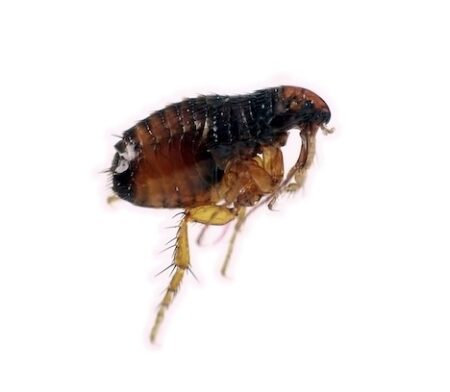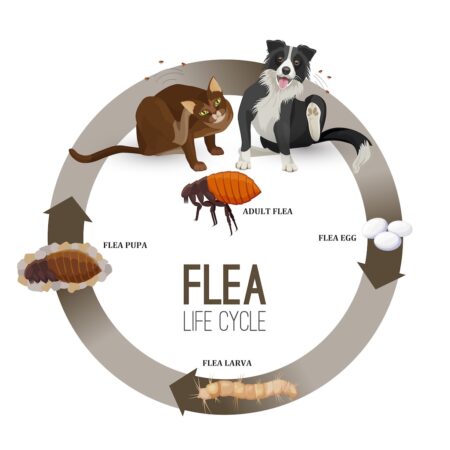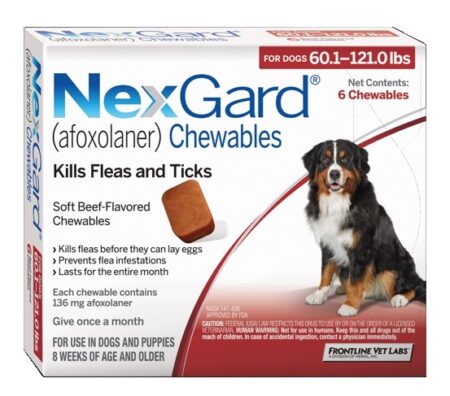
 Fleas are insects that consume blood from mammal hosts. Adult fleas are tiny, measuring only 2.5 mm long. Their bodies are shiny and reddish brown in color. Fleas do not have wings, but they can jump long distances. Several species of fleas can infest pets, but the most common one found on cats & dogs is the cat flea or Ctenocephalides felis. Fleas are a public health concern because they can transmit a variety of diseases to pets and people.
Fleas are insects that consume blood from mammal hosts. Adult fleas are tiny, measuring only 2.5 mm long. Their bodies are shiny and reddish brown in color. Fleas do not have wings, but they can jump long distances. Several species of fleas can infest pets, but the most common one found on cats & dogs is the cat flea or Ctenocephalides felis. Fleas are a public health concern because they can transmit a variety of diseases to pets and people.
 Flea Life Cycle
Flea Life Cycle
The flea has a multistage complex life cycle that can be completed in a few weeks:
- Adults – The adult fleas emerge from their cocoons and begin searching for a host. Within minutes of hopping on a pet, the fleas begin feeding on the blood of the host animal.
- Eggs – Egg production begins within 20-24 hours of female fleas taking their first bloodmeal. The eggs are deposited onto the pet & fall into the environment. Female fleas can produce over 1,000 eggs a month.
- Larvae – The larvae hatch from the eggs within days. Larvae feed on adult flea feces. The larvae develop outdoors in cool shady areas or may also be found indoors in protected sites in the carpet including under furniture.
- Pupae – Mature larvae form cocoons that can be found in soil, on vegetation, in carpets and on animal bedding. Adults emerge from the cocoon in one to two weeks depending on the temperature & humidity.
Causes
Cats and dogs can become infected with fleas in their environment or close contact with other animals.
In warmer months, infestations may take root outside your house. Feral and wild animals can bring fleas into your yard. The adult fleas can wait in cool shady areas for unsuspecting pets to pass by. In colder months fleas can jump from pet to pet by close contact at parks, kennels, play dates, and groomers. Pets will carry the fleas into you home and soon eggs will start shedding into the environment resulting in an infestation.
 Symptoms & Diagnosis
Symptoms & Diagnosis
Many signs can indicate flea activity:
- Scratching – Pets infected with fleas repeatedly scratch and over-groom themselves. For pets that are allergic to flea saliva, the bite of even 1 flea can cause intense itching.
- Irritation – Hair loss, skin redness, and crusty scabs may appear. Pets can cause significant self-trauma from chewing and scratching.
- Adult fleas – Adult fleas are visible to the naked eye. Fleas can be found on the pet by use of a fine-toothed comb.
- Flea feces – Flea dirt, the adult flea feces, looks similar to coarse ground black pepper and may be seen in the fur, pet beds, carpets, rugs and other areas where the animal host rests.
- Anemia – Young animals with severe flea infestations can experience anemia from blood loss. Puppies and kittens may become pale and lethargic with anemia.
- Tapeworms – A dog or cat may swallow a flea while self-grooming. Ingestion of fleas can infect the host with tapeworms. Owners may see pieces of rice on the stools or in the hair around their rectum. These are tapeworm segments.
A veterinarian can diagnose fleas based on the physical exam findings of skin irritation, and presence of adult fleas or flea dirt.
Treatment
Minor flea infestations that are identified early may be treated by the homeowner in consultation with a veterinarian. Moderate to severe infestations will take months to control and will require the services of an exterminator.
- Pet treatment – Every pet in the home must be treated. All pets must receive a veterinarian prescribed medication, such as Nexgard, Frontline, or Revolution, administered every month for a minimum of 3 months. Over the counter shampoos and topicals are not recommended, as they often use harsh pesticides with significant side effects and do not break the flea life cycle. Secondary skin irritation and infection may need to be addressed with steroids and antibiotics.
- Sanitation – Thoroughly clean areas where pets hang out and fleas live. The home should be vacuumed frequently to physically remove flea eggs, larvae, pupae and adults from carpeting, rugs, floors, and furniture. Regularly wash pet bedding in hot water and dry on high heat. The yard should be mowed and raked to remove excess organic debris from flowerbeds, near bushes, and under decks. Feral and wild animals entering the yard should be managed.
- Home treatment. For moderate to severe infestations, home treatment should begin at the same time as pet treatment. This helps disrupt the flea’s life cycle. A licensed commercial pest control exterminator is needed to determine which products and plan are best for inside the home and in the yard.
- Follow-up. Fleas have a complex life cycle with multiple stages. To kill fleas, multiple follow-up treatments of the pet and home are needed to eliminate all stages. In the first month, you might see fleas after using recommended products. It takes time for all the adults, larvae, pupae, and eggs to be eliminated from the environment. A minimum of 3 months of treatment for all pets is needed to resolve a flea infestation.
Prognosis
The prognosis for minor flea infestations is excellent if all pets in the home are treated with prescription medications for 3 months and the environment is cleaned regularly. The prognosis for moderate to severe infestations can be guarded. All pets in the home may need to be treated beyond 3 months and a professional exterminator will need to make multiple visits to the property. It is important to remember that fleas can carry numerous diseases; bacteria and parasites that can be transmitted to both pets and people. Diseases of concern include Typhus, Tapeworms, Tularemia, Bubonic Plague, and Bartonellosis. Pets that have been infested with fleas should be monitored closely for additional symptoms that may indicate secondary infections.
 Prevention
Prevention
Flea infections are easy to avoid with regular year-round use of safe and effective prescription medications available from a veterinarian. For dogs, Nexgard and Simparica are once monthly chewable or Frontline and Revolution are once monthly topicals that can be used to prevent fleas and ticks. For cats, Nexgard Combo, Revolution, and Frontline are once a month topicals that help prevent fleas and ticks.
Talk to your veterinarian about the best product to use for your pet. The products you buy from your veterinarian are backed and guaranteed by the manufacturers in cases of reaction or product failure.
For more information visit the Companion Animal Parasite Council www.capcvet.org/guidelines/fleas/






Recent Comments